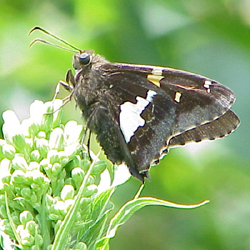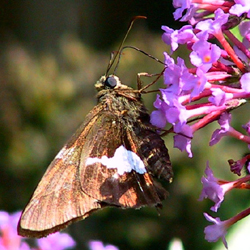Find a Butterfly
Silver-spotted Skipper
Epargyreus clarus
Named
Cramer, 1775

Identification
Wingspan 1 3/4 - 2 3/8". Our largest resident skipper. Long-winged and brown, with band of yellow-orange rectangular spots on forewings and unique, silver-white patch at center of hindwings beneath. Similar Hoary Edge is much less common, with more rounded wings and whitish smudge along outer edge of hindwings beneath.
Distribution
Southern British Columbia east across southern Canada to central New England; south to southern California, northern Mexico, and Florida. Absent from Great Basin, western Oklahoma, and most of western and southern Texas. In New England, the species occurs north to central Vermont, New Hampshire and eastern Maine.
Status in Massachusetts
Common throughout Massachusetts in historical times, with the exception of Nantucket, which has no historical or Atlas period records. Usually found in rather small numbers at any one site. Maximum: 40 on 13 July 1990, Foxboro (Norfolk Co.), B. Cassie and 184 on 17 July 1991, Xerces Count (Central Franklin Co.)

Flight Period in Massachusetts
Typically early June to mid-August. Northern populations are normally single-brooded and this is usually the case in Massachusetts. There is a partial second brood some years, however, as fresh specimens are occasionally seen during late August and there is a September record. Extreme dates: 22 May 1993, Worcester (Worcester Co.), T. Dodd and 5 September 1988, Northfield (Franklin Co.), M. Fairbrother.
Larval Food Plants
Legumes are utilized, especially locusts of the genus Robinia, including the introduced Black Locust (Robinia pseudoacacia) and Bristly Locust (R. hispida). Other documented food plants occurring in our area are False Indigo (Amorpha fruticosa), Hog Peanut (Amphicarpa bracteata), Groundnut (Apios americana), numerous tick-trefoils (Desmodium), Honey Locust (Gleditsia triacanthus), Marsh Vetchling (Lathyrus palustris), and Round-headed bush Clover (Lespedeza capitata).
Adult Food sources
Visits a wide variety of flowering plants and was found nectaring on 28 different species of flowering plants by atlas workers.

Habitat
Habitat: Open parks, fields, and suburban gardens, especially in the vicinity of locusts, the principal food plants.
Life Cycle
Life Cycle: EGG: Green, with red top; dome-shaped and highly reticulated. OVIPOSITION: Eggs laid singly on upperside of host leaf (or nearby plant - see discussion below). LARVA: Yellowish-green body, constricted neck, and large brownish head, with two prominent red-orange eyespots set at the front of the head capsule. PUPATION: Occurs in rolled-leaf cocoon in the leaf litter. CHRYSALIS: Brown, slightly pointed at one end. OVERWINTERING STAGE: As pupae.
From early June on, Silver-spotted Skippers may be observed dashing about the garden or meadow. Small, isolated Locust saplings are often the center of attention for mated females. According to Opler and Krizek (1984) , the female lays its egg on a plant near the preferred food plant but not actually on the host species. The caterpillar, upon hatching, must then search out the nearby food source. Scott (1986) asserts that ovipositing on plants not eaten by the larvae is rarely done. During the Atlas period, Tom Dodd observed several Silver-spotted Skippers ovipositing directly on the host plants Black Locust and Groundnut. Young larvae construct nests from a folded corner of a food plant leaf. Mature larvae silk together overlapping leaves for a nest.
Males are highly curious insects and frequently fly at other passing insects. Both sexes can fly with startling speed, as admirably described by Scudder: "It has a dashing, impetuous flight, starting with a plunge and stopping as abruptly; it startles the collector by its sudden advent, bewilders him by its unexpected dashes, and then vanishes like a swift arrow." Silver-spotted Skippers may occasionally be heard in the field. Their rapid wingbeats produce a whirring sound audible at close range.
Account Author
Brian Cassie



